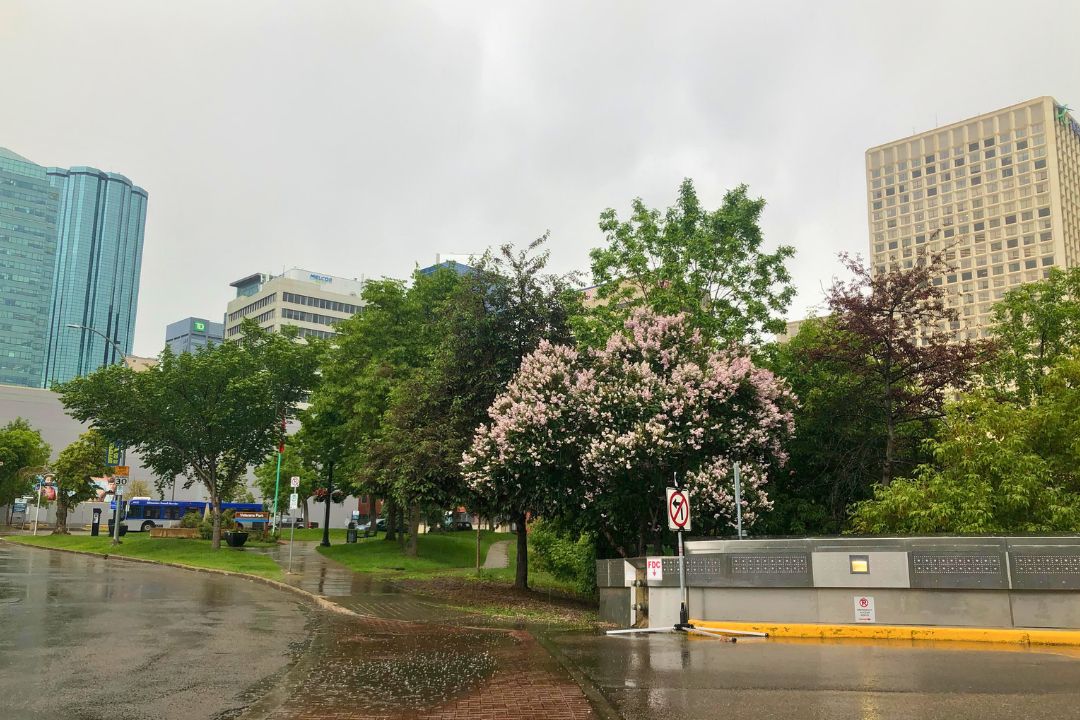An arborist and a tree historian are bringing together international experts for a one-day urban forestry conference at the Backstage Theatre on June 21.
"We've identified a handful of presenters whose voices are important but maybe (are) not the loudest voices in the room typically," said Dustin Bajer, co-organizer of the Spoke n' Loam conference.
Bajer operates a tree nursery in his backyard and teaches others how to do the same through his Shrubscriber subscription community. He also works with the Edmonton Heritage Council to catalogue the city's large, old, and unique trees. His co-organizer, Emi Wekwert, is an arborist certified by the International Society of Arboriculture.
While a typical forestry conference might bring together resource management professionals to learn about lumber, pulp, and forest fires, this conference is more concerned with individual trees in an urban environment. "In a city context, it's a lot more about maintaining tree health so that the trees can provide ecosystem services, and economic value, and duty to the city itself and to individual homeowners," Bajer said.
Trees can increase a neighbourhood's livability, mitigate extreme weather caused by climate change, and could even be linked to a decrease in crime, Bajer said. "Maintaining the health of our urban forest canopy is a way that we can actually indirectly address a lot of challenges that we have, be it social or environmental, especially when we're talking about the mitigation of the impact of climate change."
The conference includes six presentations, each followed by a Q-and-A.
Bajer will support Yong Fei Guan's presentation about Goji berry trees in Edmonton. The fruit tree is native to Asia but was brought to Edmonton by Chinese workers, who came here to help build the continental railroad in the late 1800s. Goji shrubs can grow comfortably in Edmonton, including in the river valley. Guan is a researcher and artist who created the Edmonton Goji Map. The map illustrates that the most visible Goji shrubs are concentrated in the McCauley area. Guan used software that Bajer helped develop while researching heritage trees.
Dave Lutes, an Indigenous arborist from Manitoba, will share his experiences becoming a knowledge keeper, and speak about the interconnection between trees, culture, and recovery. Katie Breukers will discuss how climate change is contributing to fungal pathogens and the deterioration of urban tree health, a field she studies at the University of New Brunswick. Dana Green, a bat ecologist and PhD candidate at the University of Regina, will talk about bat species that roost in trees and how to avoid harming wildlife.
Toni-Marie Newsham and Charlene Scott are on the ISA's Prairie Chapter Women in the Trees committee. The two will explore how arborists will change the future ecosystem and how that can steer arborist decisions today. Jack Novak and Jeremiah Sandler of Tree First Arboriculture, based in Detroit, will speak about the company's emerging "practitioner model" for arboriculture.

Trees in cities can help mitigate extreme weather from climate change, are linked to a decrease in crime, and can make a neighbourhood more livable, according to the organizer of an urban tree conference. (Stephanie Swensrude)
The City of Edmonton hopes to plant two million trees by 2030 and see the canopy cover 20% of Edmonton by 2071.
Bajer said some City of Edmonton employees have registered for the conference, as well as staff from the City of Leduc, City of St. Albert, and Parkland County.
"Our goal here has been to find some of those slightly less heard-from voices or folks in the community who don't have the opportunity, necessarily, to share the stuff that they're doing, but are really doing very interesting things," Bajer said. "If we can use the event to highlight the work that they're doing and bring that to the local arboriculture community, I think that … has the potential to change conversations a little bit."
Bajer said he hopes anyone who cares about trees, biodiversity, and conservation attends the conference, as well as people who work as arborists.
"As an example, myself, not an arborist — don't particularly like heights, I like hanging out on the ground and looking at my trees from the ground," he said. "But I'm very interested in the cultural, the horticultural, the environmental value that healthy urban forests can bring to the table."
Bajer spoke to Taproot from the Cloverdale neighbourhood in the river valley, and described what he could see from his window. "I see a big white spruce — that's a big native plant, but I'm also looking out the window and I'm seeing the green ashes that the city has planted in the boulevards, and that's a species from further out east.
"All of these plants that I'm looking at out my window have all been intentionally planted," he said. "The health of our urban forest is really a reflection of the people who planted it, and the people who maintain it, and so it's a nice-to-have but it's also a cultural artifact."
